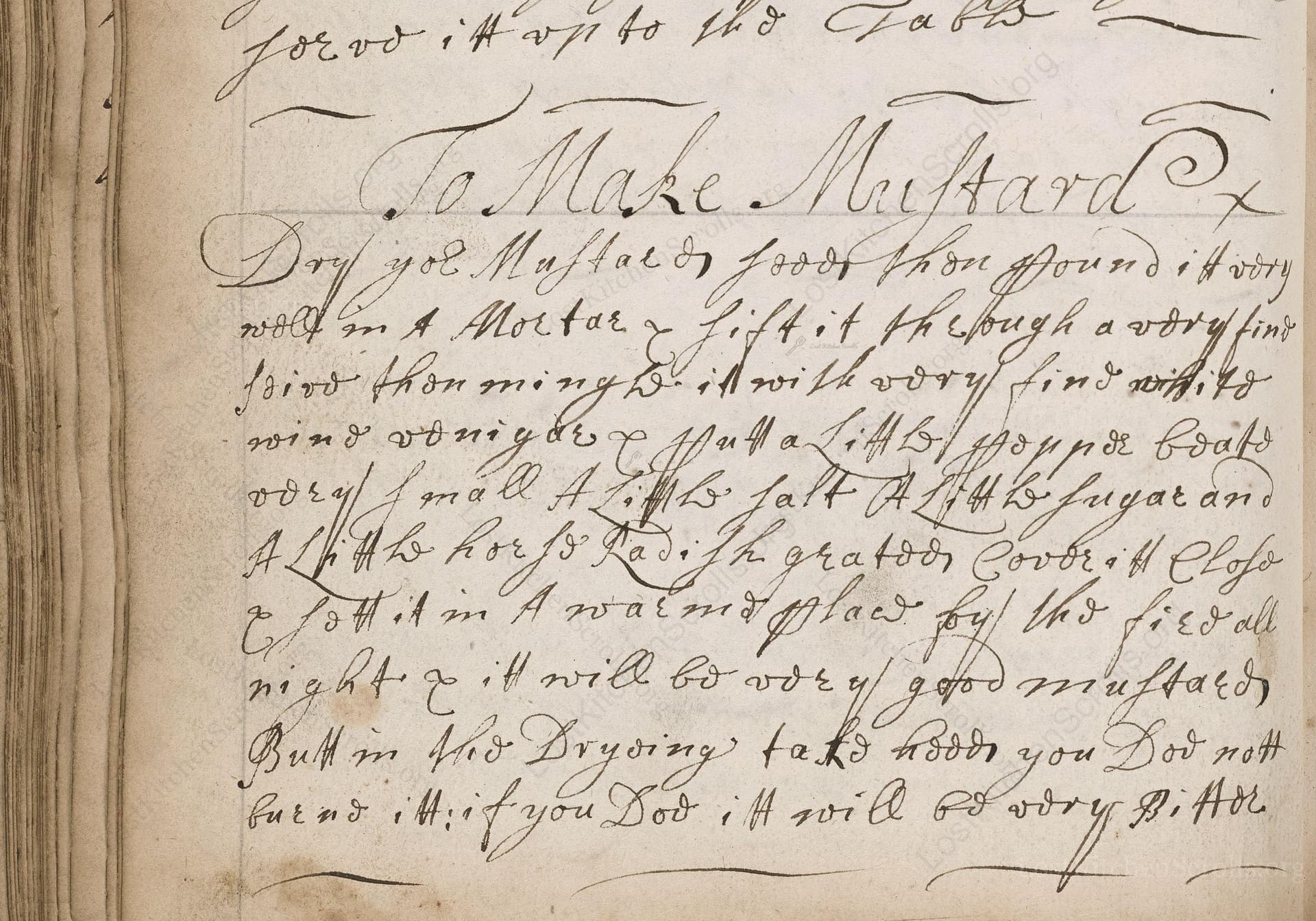To Make Mustard
From the treasured pages of Cookbook of Ann Smith, Reading
Written by Ann Smith

To Make Mustard
"Dry your Mustard Seed then pound it very well in a Mortar & sift it through a very fine Sive; then mingle it with very fine salt & wind & viniger & this a little pepper & this very small & a little salt & a little Sugar and a little horse Radish grated; Cover it Close & sett it in a warme place by the ffire all night & it will be very good mustard; But in the Drying' take heed you Doe nott burn'd; if you Doe it will be very Bitter"
Note on the Original Text
Written in the brisk, abbreviated handwriting typical of household recipe books from the 17th century, the recipe relies on the reader’s culinary intuition and experience. Spelling can be idiosyncratic (e.g. 'sive' for 'sieve', 'viniger' for 'vinegar', 'wind' perhaps an error or a word lost in transcription). Repetition and irregular punctuation show it was intended for personal or family use, not for publication. Such recipes assume familiarity with basic processes and local ingredients, making them charming windows into past kitchens.

Title
Cookbook of Ann Smith, Reading (1698)
You can also click the book image above to peruse the original tome
Writer
Ann Smith
Era
1698
Publisher
Unknown
Background
Step into the sumptuous kitchens of 17th-century England with Ann Smith’s culinary treasury, where traditional recipes and time-honored techniques invite you to savor the flavors of history. Each page promises a feast of inspiration and a glimpse into the artful dining of a bygone era.
Kindly made available by
Folger Shakespeare Library
This lively mustard recipe comes from Ann Smith's recipe collection, dated 1698. In the late 17th century, English households made their own condiments, with mustard being a popular staple at the table. Recipes like these would have been handed down or traded between literate women who managed kitchens for wealthy households. The inclusion of horseradish marks it as a punchy, rustic version reflecting local tastes before commercial mustards became widespread. At the time, recipes were concise notes or reminders rather than precise instructions. Seasonings were often adjusted to taste, and fermentation or overnight resting was common to mellow sharp flavors.

The original cook would have used a mortar and pestle for pounding the mustard seeds, a fine sieve for sifting, and a grater for the horseradish. The mixture would rest in a ceramic or stoneware jar, covered with cloth or a tight-fitting lid. The warming process called for setting the jar near the hearth or fireplace, relying on gentle, ambient heat to encourage the mixture to mature overnight.
Prep Time
10 mins
Cook Time
30 mins
Servings
8
We've done our best to adapt this historical recipe for modern kitchens, but some details may still need refinement. We warmly welcome feedback from fellow cooks and culinary historians — your insights support the entire community!
Ingredients
- 1 3/4 ounces mustard seeds
- 1/2 teaspoon fine sea salt
- 1/8 teaspoon ground black pepper
- 1/2 teaspoon granulated sugar
- 1 tablespoon finely grated horseradish root (or prepared horseradish, well-drained)
- 3–4 tablespoons white wine vinegar
Instructions
- Begin by spreading 1 3/4 ounces of mustard seeds on a baking tray and dry them gently in an oven at no more than 175°F for roughly 30 minutes, shaking occasionally and being careful not to let them darken or burn, as this will make them bitter.
- Next, use a mortar and pestle or spice grinder to pound the dried mustard seeds into a fine powder, then sieve to remove any coarse bits.
- Transfer the ground mustard to a bowl.
- Stir in 1/2 teaspoon of fine sea salt, a generous pinch (about 1/8 teaspoon) of finely ground black pepper, and 1/2 teaspoon of granulated sugar.
- Add 1 tablespoon of finely grated horseradish root (or if unavailable, use prepared horseradish, drained of excess liquid).
- Slowly mix in about 3–4 tablespoons of white wine vinegar until the mixture forms a thick, smooth paste.
- Cover the bowl or transfer the mustard to a jar, seal well, and place near a warm area (such as beside your stove or near a gently heated oven) overnight to let the flavors meld.
- The next day, your mustard is ready to use.
Estimated Calories
12 per serving
Cooking Estimates
Preparing homemade mustard with horseradish takes about 10 minutes for the ingredients, plus 30 minutes to dry the mustard seeds in the oven. You then let it rest overnight so all the flavors blend. One batch makes about 8 servings, each with roughly 12 calories.
As noted above, we have made our best effort to translate and adapt this historical recipe for modern kitchens, taking into account ingredients nowadays, cooking techniques, measurements, and so on. However, historical recipes often contain assumptions that require interpretation.
We'd love for anyone to help improve these adaptations. Community contributions are highly welcome. If you have suggestions, corrections, or cooking tips based on your experience with this recipe, please share them below.
Join the Discussion
Rate This Recipe
Dietary Preference
Main Ingredients
Occasions

Den Bockfisch In Einer Fleisch Suppen Zu Kochen
This recipe hails from a German manuscript cookbook compiled in 1696, a time whe...

Die Grieß Nudlen Zumachen
This recipe comes from a rather mysterious manuscript cookbook, penned anonymous...

Ein Boudain
This recipe comes from an anonymous German-language manuscript cookbook from 169...

Ein Gesaltzen Citroni
This recipe, dating from 1696, comes from an extensive anonymous German cookbook...
Browse our complete collection of time-honored recipes



